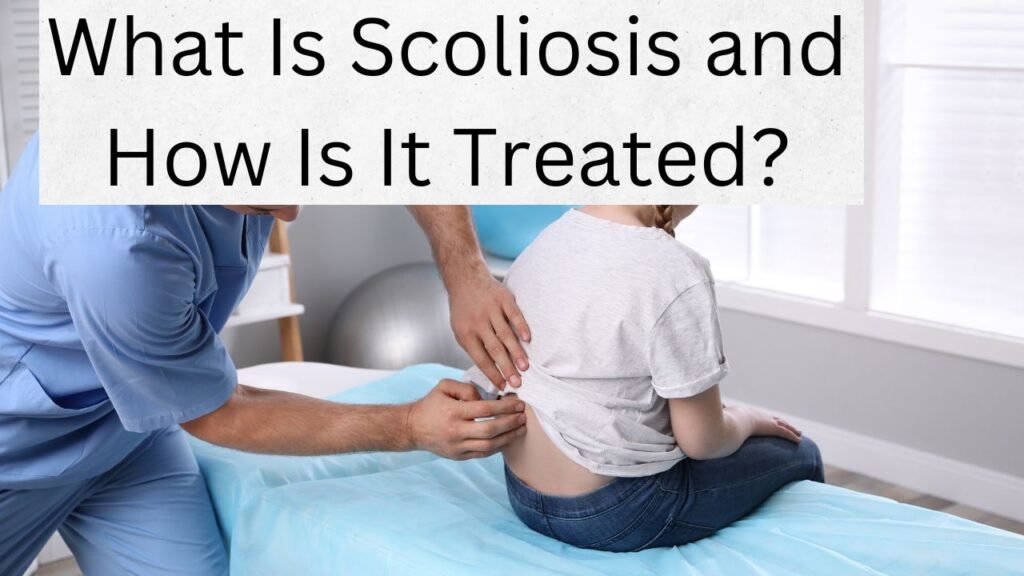Scoliosis is a condition where the spine curves sideways, often forming an “S” or “C” shape. While mild cases may not cause noticeable issues, severe scoliosis can lead to pain, posture problems, and even breathing difficulties. Understanding scoliosis, its causes, symptoms, and available treatments is essential for managing the condition effectively.

Causes of Scoliosis
Scoliosis can develop for various reasons, but in most cases, the exact cause remains unknown. The main types include:
- Idiopathic Scoliosis – The most common type, usually appearing during adolescence without a known cause.
- Congenital Scoliosis – Present at birth due to spinal abnormalities during fetal development.
- Neuromuscular Scoliosis – Occurs in individuals with conditions like cerebral palsy or muscular dystrophy.
- Degenerative Scoliosis – Develops in adults due to spinal degeneration, arthritis, or osteoporosis.
- Functional Scoliosis – Caused by muscle imbalances, leg length discrepancies, or posture-related issues.
Symptoms of Scoliosis
The severity of scoliosis symptoms varies depending on the degree of spinal curvature. Common signs include:
- Uneven shoulders or hips
- One shoulder blade sticking out more than the other
- An asymmetrical waistline
- Leaning to one side
- Back pain, especially in adults
- Breathing difficulties in severe cases
Scoliosis is often detected during routine checkups or school screenings. A doctor may perform a physical examination and order imaging tests such as X-rays, MRIs, or CT scans to confirm the diagnosis.
Treatment Options for Scoliosis
The treatment approach depends on factors like age, severity of the curve, and whether the condition is worsening. The main options include:
1. Observation and Monitoring
For mild scoliosis (curves under 20 degrees), doctors may recommend regular monitoring through X-rays to ensure the curvature doesn’t worsen over time. This is especially common in growing children.
2. Bracing
Bracing is an effective non-surgical treatment for children and adolescents with moderate scoliosis (curves between 20-40 degrees). A custom-fitted brace helps slow or stop the progression of the curve while the spine is still growing. Common types of braces include:
- Thoracolumbosacral Orthosis (TLSO) – A rigid brace worn under clothing.
- Milwaukee Brace – A full-torso brace with a neck ring (used in severe cases).
Bracing does not reverse scoliosis but can prevent it from worsening.
3. Physical Therapy and Exercise
Physical therapy plays a crucial role in managing scoliosis. Specific exercises help strengthen the core muscles, improve posture, and enhance spinal flexibility. Popular techniques include:
- Schroth Method – A specialized therapy focusing on breathing techniques and postural correction.
- Yoga and Pilates – Beneficial for improving flexibility and spinal alignment.
- Strength Training – Helps stabilize the spine and improve muscle balance.
While exercise won’t straighten a curved spine, it can alleviate pain and improve overall function.
4. Chiropractic Care
Chiropractic adjustments can offer temporary relief from scoliosis-related discomfort. However, there is no scientific evidence that chiropractic care can permanently correct spinal curvature. It should be used as a complementary therapy rather than a primary treatment.
5. Pain Management
Adults with scoliosis often experience chronic back pain. Pain relief methods include:
- Over-the-counter pain relievers (ibuprofen, acetaminophen)
- Prescription medications for severe pain
- Epidural steroid injections for nerve-related pain
- Heat and cold therapy
- Massage therapy
6. Surgery for Severe Scoliosis
Surgery is considered for curves exceeding 45-50 degrees, especially if the condition affects breathing or causes severe pain. The most common surgical procedure is spinal fusion, where metal rods, screws, and bone grafts are used to stabilize and straighten the spine. Other surgical options include:
- Growing Rods – Used in young children to allow spinal growth while controlling the curve.
- Vertebral Body Tethering (VBT) – A less invasive procedure that allows for some spinal flexibility.
Surgical outcomes are generally positive, but recovery can take several months.
Can Scoliosis Be Prevented?
While scoliosis itself cannot always be prevented, certain habits may help reduce the risk of complications:
- Maintain good posture – Slouching doesn’t cause scoliosis, but proper posture can reduce strain on the spine.
- Stay active – Regular exercise strengthens the core and improves spinal support.
- Ensure proper ergonomics – Use supportive chairs, avoid carrying heavy bags on one shoulder, and practice correct lifting techniques.
- Early detection – Routine screenings can help catch scoliosis early, preventing progression.
When to See a Doctor
Seek medical advice if you or your child notice signs of scoliosis, such as uneven shoulders, back pain, or an unusual spinal curve. Early diagnosis increases the chances of successful treatment and prevents complications.
Conclusion
Scoliosis affects people of all ages, but early detection and proper treatment can prevent severe complications. Mild cases may only require monitoring, while moderate scoliosis might need bracing or therapy. Severe cases sometimes require surgery. Understanding your options empowers you to take control of spinal health and improve quality of life. If you suspect scoliosis, consult a healthcare professional for the best treatment plan tailored to your needs.